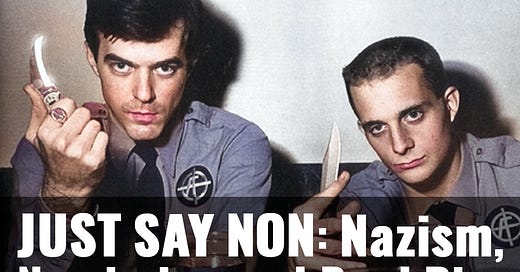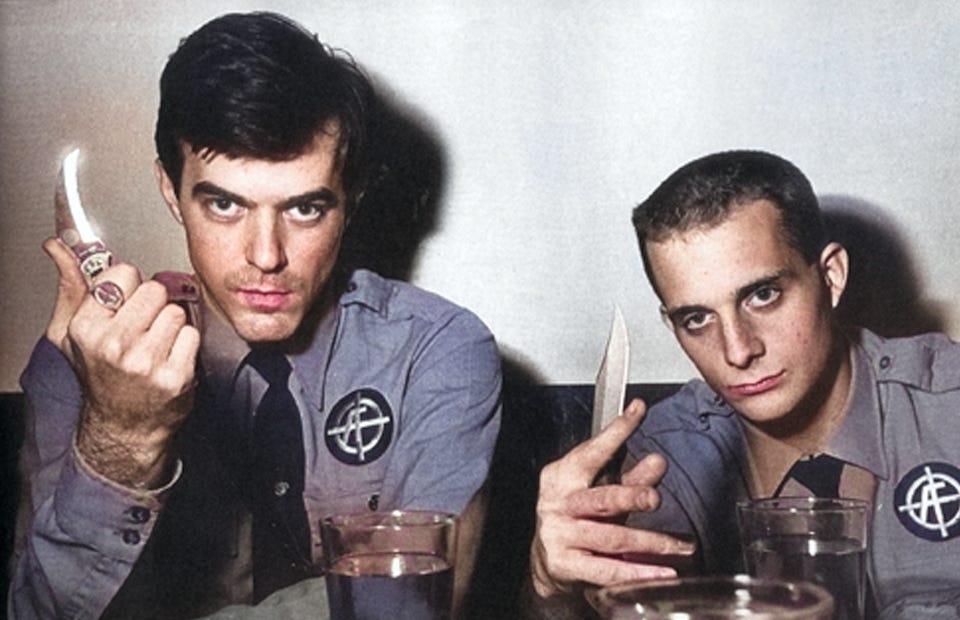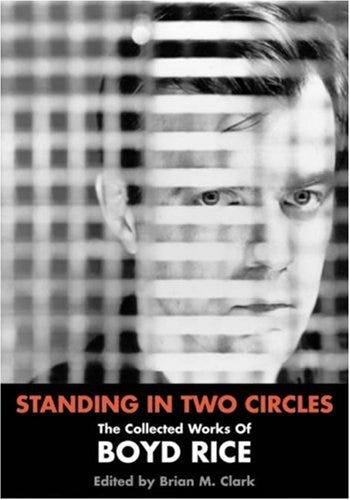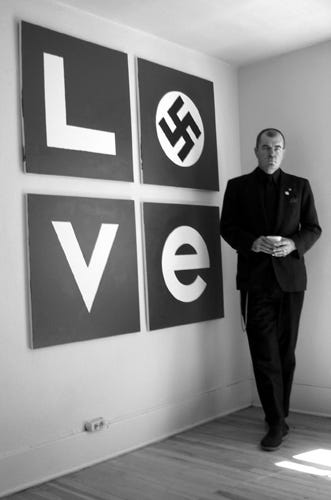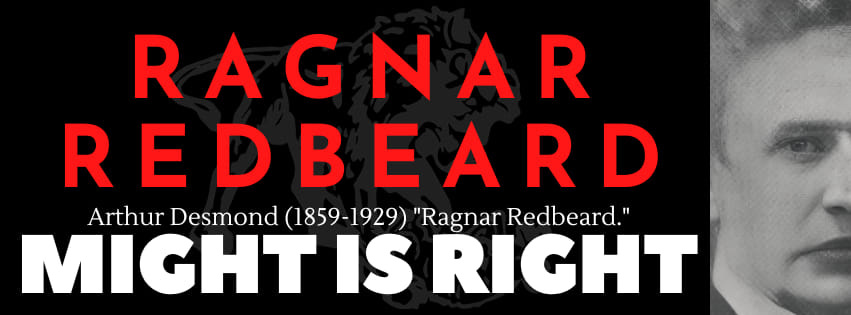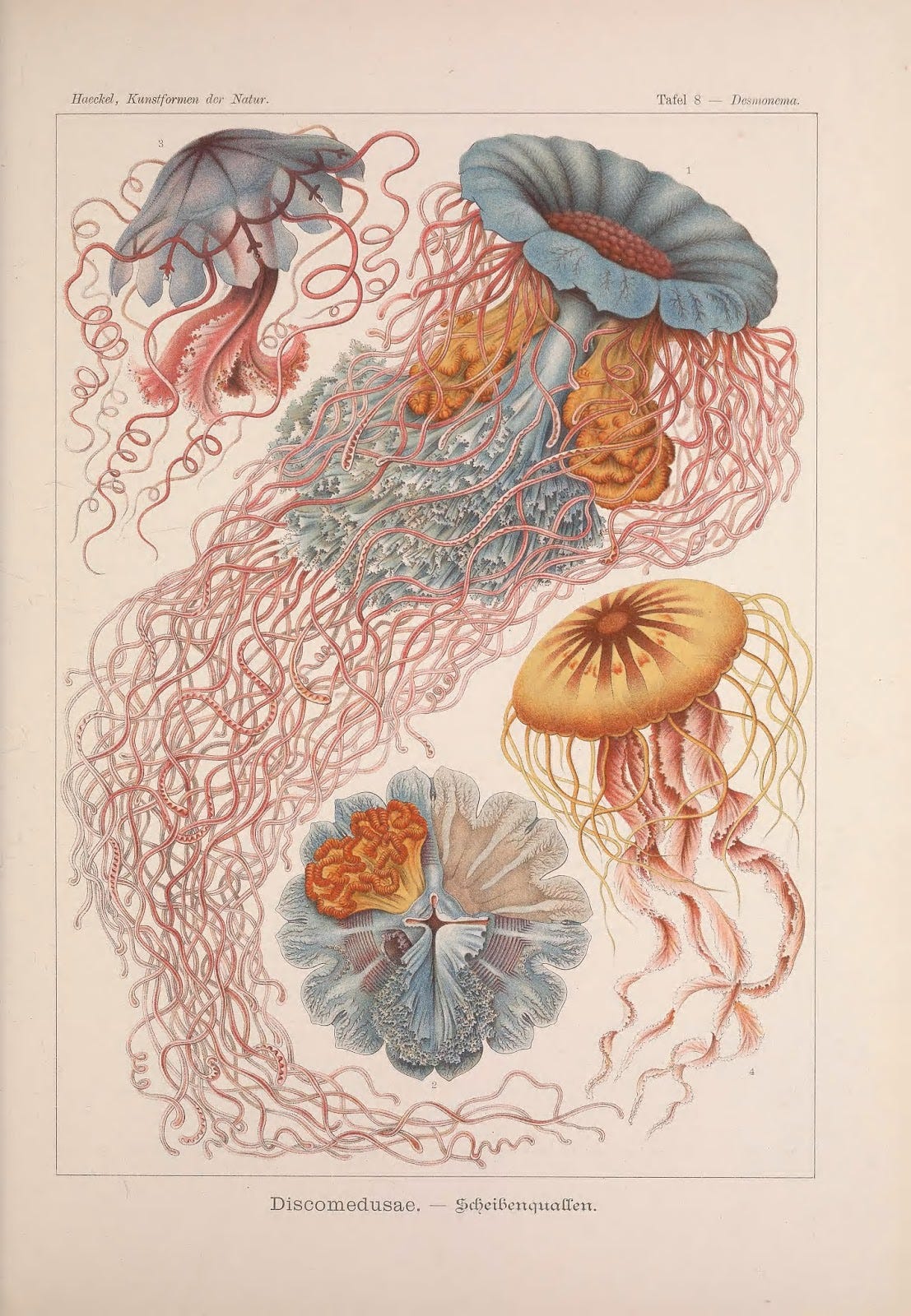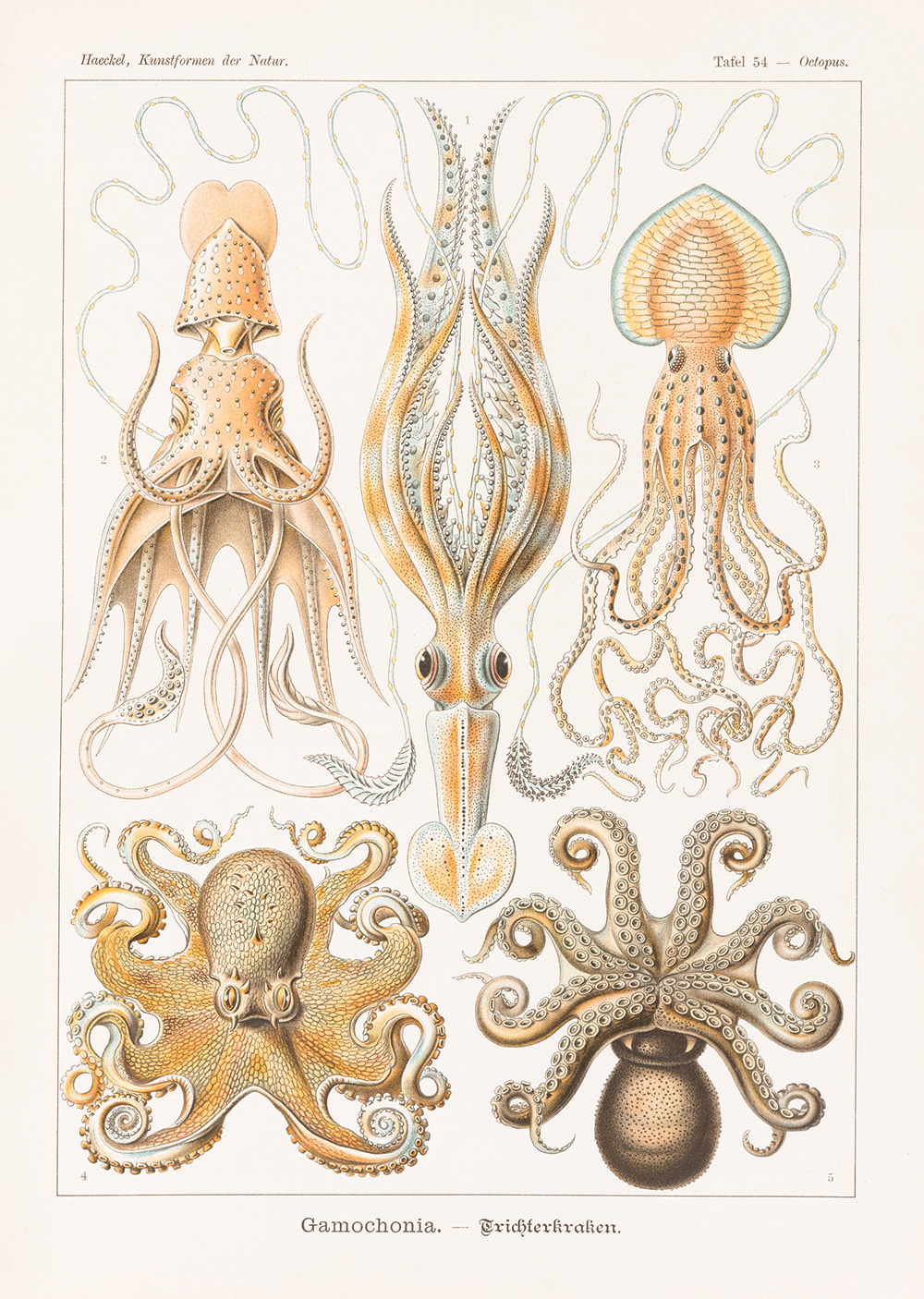Just Say 'Non': Nazism, Narcissism and Boyd Rice
Published 15 years ago, this review of Boyd Rice's peurile book is interesting despite the fact that the people who supported him have since gone overground as part of MAGA, and things have moved on.
I saw Boyd Rice play (as 'Non') back in August 1981, alongside Throbbing Gristle (TG), Z'ev, Cabaret Voltaire and Clock DVA as part of the 'Industrial Night Out' at the Lyceum, London, which brought together the big cheeses of Industrial Music for what was clearly intended to be something of a coming out party for the scene, but turned out also to be its swansong (it was TG's last UK concert before they broke up).
Rice then presented himself as a Dadaist and prankster, though his aesthetic was closer to the sub-Futurist 'instant karma for kids' noise-racket Merzbow has since turned into a brand / 'racket' of his own. While Throbbing Gristle made music from ugly noise, Rice sought to outflank them by serving up the ugliness directly, unfiltered by any concern for form, other than his branding.
Rice was one of the key players in early Industrial Music. As a result, he has more kudos than some of the non-entities he has worked with since.1 Rice has expressed his fascism in many statements, in his art, and through public actions such as appearing in fascist regalia, holding a dagger, in a photograph alongside Bob Heick, taken in 1989 to promote the latter's organisation, the neo-Nazi skinhead party, American Front. Rice has also appeared on White Aryan Resistance founder Tom Metzger's cable TV show Race and Reason, where he declared that he and his friends in Current 93 and Death in June were promoting a 'racialist' agenda and emphasised the importance of Industrial and Neo-Folk music for building the 'Aryan youth movement'.
Since the 80s Rice has continued to release records as well as dabbling in other media (photography, painting) and playing a role in the Church of Satan (he was recently installed as its leader and 'High Priest') as well as getting involved with Grail mythology, Tiki culture, alcoholism and various other similarly dumb pastimes. Along the way, he's written essays and articles outlining his evolving concerns and hobbies for a string of publications, which are collected here along with some previously unpublished writings in the book Standing in Two Circles: The Collected Works of Boyd Rice (2008).
This collection offers an opportunity to pin down the peculiarly slippery Rice; 'slippery' because his defenders claim that he sets out essentially to 'provoke', which lends him a degree of insulation from the charges of fascism that would be trivially obvious in another context. Rice can openly declaim and publish fascist and racist ideas, yet confused fans and assorted apologists, who have bought into the idea that provocation in and of itself is the ne plus ultra of artistic radicalism, refuse to accept that by buying his records and attending his gigs they are financing a fascist propagandist since, after all, he is 'merely' trying to provoke.
Perhaps these people are so utterly stupefied that they're grateful to anyone who can still manage to wring a response out of them - even if it's by promoting ideas that threaten them. This was brought home to me earlier this year when a photographer friend attended Rice's gig in New York to record it for a local paper. Although this person has a background as an anti-fascist, having watched Rice dressed in fascist military gear, surrounded on stage by Sieg Heil'ing Nazi goons while projecting images of the Swastika and Wolfsangel (the SS symbol Rice used for years as his logo) and reading selections from racist, Social Darwinist tracts, and with the support groups being open White Suprematists, the best he could come up with at the end was that Boyd might perhaps be ‘a little dodgy’. What does a fascist have to do these days to get the recognition they deserve?
One reason Rice's ideology is difficult to get to grips with is that he is patently stupid, meaning that people are loath to take him seriously in case it reflects poorly on their sense of humour or proportion. But that is to miss that condescending to Rice's idiocy by not taking him seriously makes it easier for him to sell his ideas. While fascist ideology is by its very nature irrational and essentially incoherent - it doesn't seek to understand the social world to place it under collective human control but rather to justify post hoc the fascist's pre-existing drive to annihilate parts of society in the name of racial and spiritual 'purity' - this is made worse in Rice's case due to his inability to grapple in even the slightest way with history, politics or anything else requiring a modicum of intellectual focus.

His arguments are confused and contradictory. He also shares the fascist-occult regard for portents and symbols, for 'mysterious forces', innate biological imperatives, occult machinations and Chthonic powers as the determinants of history, which means that his thought necessarily has the chaotic, cobbled-together quality of childhood obsessions and superstitions.
Even though there is very little logic or sense in his thought there is another kind of coherence at work to the extent that his obsessions cohere with those of his comrades, overlapping neatly with those of the other players in the fascist-occult 'apoliteic' counter-culture. Their ideas may well be an incoherent mess when considered as ideas, but they share them in common in practical terms as they thrust their hands into the lucky-dip bowl of fascist esoteric idiocy to pluck out those notions they like they sound of and dole them out among their peers.
So it's no surprise that in these essays Rice touches on many of the core themes that tie him to the likes of Michael Moynihan, Doug Pearce and other musicians he has collaborated with over the years (both Moynihan and Pearce provide blurb texts promoting the book; Pearce even providing a rare dash of humour when he salutes Rice as an "inspirational genius").
These people may be in different stages of denial or employing different degrees of deception when it comes to admitting their fascist allegiances, but they draw from the same pool of half-baked atavistic notions and gladly share what they find, disagreeing only in points of detail (and then largely only on the basis of differences in taste or as a matter of brand positioning). Among fascist ideologues ideas exist only to fuel a mobilising myth: coherence doesn't matter that much. But while it is impossible to take Boyd Rice seriously as a man or a thinker, it would be irresponsible not to register the threat his ideas represent.
A good place to start into this mess of a book is Michael Clark's 'Introduction', which helpfully sets the scene by running through the set-piece arguments the fascists and their supporters use in their defence. First up is Clark's explanation for Rice's use of fascist motifs;
To conform to the edicts of contemporary Western social mores one must totally accept or reject controversial taboo subjects... In considering the issue of Nazism, for example, there can be no grey area, no possibility whatsoever that certain facets of such a subject might hold a kernel of merit or glimmer or redemptive worth...
The use of Fascistic or Nazi aesthetics and symbolism is resolutely - aggressively - forbidden in all but the most comedic of contexts, while... the Hammer and the Sickle and The Red Star are so ubiquitous as to verge on countercultural corporate branding... Adolf Hitler and Benito Mussolini are unilaterally and universally anathematised, while their despotic Communist counterparts Joseph Stalin and Mao Tse Tung and regularly given a pass - despite the fact that the latter wrested exponentially more human life from the planet than did the former.2
Fascist iconography is “resolutely forbidden”, and this si why he is keen to sell you a book full of such imagery, available on Amazon: curious. The other thing to note is that Clark skirts the fact that Rice not only uses fascist 'aesthetics and symbolism' but promotes fascism itself (in the very book Clark is introducing, for example.) Clark presumably hopes the reader is as stupid as his author and won't notice this clumsy equivocation.
This line of argument also exemplifies one of the defining characteristics of the book, as it remains trapped entirely in the framework of bourgeois thought: Rice his friends repeatedly accept the liberal perception of the world and then simply flip its conclusions (from ‘fascism is taboo’ to ‘fascism is groovy’). This doesn’t allow the consumer to escape bourgeois thought in the manner promised on the tin, but keeps them entirely in its clutches, albeit looking a little racier now they sport Totenkopf patches and worship Satan.
Stalinism did indeed slaughter millions on the road to conquering and consolidating social power. But Stalinism and fascism don’t represent political antitheses in the way both Clark and fascist thought generally assume. They are different forms of rule peculiar to different stages of capitalism. Stalinism and fascism murdered Jews, homosexuals, national minorities,'revisionists' and backsliders, trade unionists and socialists: the difference is that Stalinism in Russia, China and elsewhere did so as part of a process of primitive (state-) capitalist accumulation similar to that of Britain at a corresponding stage of development, with the slave trade and Highland Clearances (Stalinism appears bloodier mostly because it compressed the same phase of development into a shorter period).
This doesn’t justify Stalinist violence, but it starts to explain it. Fascism serves a different end. It is a form of emergency rule at a time of capitalist crisis in which the subaltern classes are terrorised and flattered into submission. Fascism has its ideologies, but they are subordinate to its task of integrating and stabilising capitalist society at times of danger by neutralising its enemies, real and imagined (those impure and degenerate elements as defined by whatever myth or prejudice inspires any particular strand of fascism). This is done in order to create an 'organic' / integral society with all its parts subordinated to the social totality, existing only to serve it.
All this is opaque to Clark, who talks instead like a consumer in the shopping mall of history, choosing between competing brands of totalitarianism on the basis of which is less fattening for his notional conscience. He counts the bodies but doesn’t understand the ideas that justified their deaths. Instead of considering the politics of Rice's fascism, he presents Rice simply as someone 'brave' enough to challenge the 'taboo' against fascism, as if he might shake bourgeois society to its core by invoking the negative theology it wraps itself in.
But this taboo is, after all, only the socially constructed fetish of a particular epoch and doesn't mean that crisis-ridden capitalism won't reach toward fascism again in future (we see you, Donald Trump). This turn will be made easier to the extent that ideologues and propagandists, even feeble ones like Boyd Rice, helped clear the road back to fascism by normalising its anti-democratic values.
The identical logic is wheeled out in Clark's defence of Satanism;
The Church of Satan is often dismissed outright as illegitimate by practitioners of more established belief systems... it's difficult to deny that conventional organised religion has been responsible for scores of large scale wars, genocides, inquisitions, witch hunts, crusades and other varieties of human strife over the centuries, but one would be hard pressed to find so much as a single example of a major conflict undertaken in the name of Satan.3
Once again, the ignorance of basic historical processes (if it isn't entirely feigned) is astonishing. Does he imagine that the Crusades were simply a pious expression of Christian values, as opposed to social and political struggles? Clark takes religious ideology at its word and assigns to it a primordial power over events.
Worse than this, in treating Satanism as an abstract negation of Christianity he ignores the positive content that modern Satanism developed, rooted in racist and proto-fascist ideas. Modern Satanism begins with the work of Howard Stanton Levey (aka Anton LaVey) and his Church of Satan. As is well known, the key text of his church, The Satanic Bible, which has influenced all Satanist cults since, plagiarises the 19ᵗʰ Century Social Darwinist tract Might is Right, by Arthur Desmond (aka Ragnar Redbeard), a work brimming with anti-Semitism and racism.
Partly as a result of LaVey's promotion of it, Desmond's book is a favourite of modern racists, right-wing libertarians and fascists, and was even republished by 14 Words Press, the company founded by David Lane, the Klan member who led the armed Fascist group, The Order, and died in prison after being convicted of conspiring in the murder of Denver Radio talk show host (and Jewish anti-Fascist) Alan Berg.
Entire sections of Might is Right are transplanted wholesale into Levey's Bible. If Satanism has not yet proved as practically malevolent as Christianity in Clark's estimation it is certainly not for the want of trying by those who have taken Levey's teaching to its logical conclusion, such as Lane and the members of various Nazi-Satanic cults.
As a collection of occasional pieces, it's hard to get to grips with Rice's book as such because of the disparate nature of his interests. Large parts document his obsession with ephemera: he discusses things such as novelty soaps, The Lawrence Whelk Retirement Home and Museum, bumper stickers and campaign ribbons, Disneyland, Tiny Tim, 'Leave it to Beaver', Martin Denny and Tiki bars, Mondo films, bubblegum pop and similar avowedly lightweight culture. I've heard it said that Rice's love of trivia means he can't really be a fascist since he doesn't take anything that seriously (whereas Fascists are presumably permanently serious, focused on the tasks of history). That is to seriously overestimate the fascist mind, which is perfectly at home with the banal, the kitsch and the maudlin.
Rice's debunking attitude is presented as a levelling, critical iconoclasm, but it expresses a systematic and thoroughgoing narcissism which ultimately sees everything other than his own inflated ego as essentially worthless. This perhaps represents the point at which fascist narcissism blends into postmodern affectlessness. For this class of fascists, the social world really is a meaningless pit. In Boyd Rice's mind, a bar of novelty soap might well be the perfect symbol of the vacuity of social life. The twist is only that Rice revels in this vacuousness; "it is my view that the best way to inoculate oneself against the prevailing dystopia is to simply decide to love it".4 Boyd celebrates the trivial because, as Terry Eagleton put it, "nihilists and buffoons are allergic to the slightest hint of significance".5
In 'Burning the Ice' (1989) Rice recalls "one of the pivotal episodes of my youth", in which he peeks through a picture window as an anonymous man irons his shirt, makes himself a sandwich, and packs his lunch before setting off in his car for work. "I was horrified", says Rice.6 This shocking experience leads him into a life of opposition to conventional morality, which expresses itself through stealing money from purses he finds in the cloakroom at parties, and breaking into his neighbour's flats to sniff around: terrifying stuff
In 'Sin in the Suburbs' (1994) he details his early sexual experiences, including an unintentionally hilarious story about how he was told as a youngster that every time he masturbated he was destroying the millions of potential souls contained in his sperm. This naturally led him to embark on a prolonged course of intense wanking. The image of the red-faced Rice furiously pulling on his cock while fantasising impotently about annihilating non-existent Christian souls seems somehow a fitting tribute to the man and his career.
Things take a more genuinely sinister turn when, as the next stage in the carefully curated development of his psychopathy, he decides to stalk a waitress from a local restaurant. He follows her around to learn about her daily movements and then engineers a 'chance' meeting with her on her way home from work. This leads to a date after which, back at the woman's flat, he talks her into letting him tie her up for some S&M fun. Once she is bound he goes into the kitchen to fetch a carving knife then convinces the woman that he is going to cut her open. He then suddenly departs, leaving his victim terrified. Such violent misogyny (real or imagined) would become a staple of Rice's life. In 1994's 'Revolt Against Penis Envy' (notice the acronym) he works himself up into a fever of hatred and contempt for women;
At one time all was right with the world. It was lorded over by men who imposed their will by force. Women kept their mouths shut, underlings knew their place... In a once glorious past, woman was a creature without rights; a second class citizen... She was part cook, part whore, part servant and all child... Woman must be put in her place... These days the only way to restore balance between the sexes is by fear and pain... Rape is the act by which fear and pain are united in love... Now is the time to subjugate. Now is the time to dominate. Now is the time to rape. Let the RAPE commence. Go forth! Rise up! Rape, rape, rape!7
Clearly this was written as a provocation and, according to the reasoning usually applied to Rice, can't be taken entirely seriously. But why not? If the ideas conform to his practice we can assume that for all that these opinions are expressed to 'provoke', they nevertheless represent his thinking. In Drugs are Nice, Lisa Crystal Carver (aka Lisa Suckdog) details the long-term mental and physical abuse she suffered as Rice's partner and the mother of their child, leading to a brutal attack which saw her badly injured and Rice imprisoned ("Boyd strangled me and threw me against walls and bashed my head against the futon frame, [finally he] released his hands from my neck and stood up, dazed, like a big, stupid oaf and smacked his lips with the satisfaction of having given in to impulse").8
Other parts of Rice's book concern individuals who have become icons for the Fascist counter-culture; Anton LaVey, Savitri Devi and Charles Manson. In 'I'll Call You Abraxas' (1994) Rice details his various meetings and interviews with Manson. Indeed, Manson gave this book its title, having said to Rice, "I'll call you Abraxas, because you stand in two circles at once" (Abraxas being a Gnostic deity which Rice believes, after Jung, is "the ultimate archetype", being beyond all dualities - and therefore 'beyond good and evil').9
Rice claims to have been a fan of Manson since his teenage years. He also claims it was him that took Throbbing Gristle out to Manson's base at Spahn Ranch to have the photographs taken which appeared in Re:Search's early feature on TG, and which cemented the association between them and Manson. Naturally, Manson is a hero to Rice, and a font of tremendous wisdom;
... he seemed to be an expert in many things... He knew about ancient history and current history, and the forces that shaped both. He seemed to posses a comprehensive overview of the history of the whole world; not just the events as they are presented, but all the unseen factors that preceded and resulted from those events.10
Even Rice cannot fail to notice that Manson is a fantasist (at one point he tells Rice that his supporters have hijacked a fleet of nuclear submarines and are holding the leaders of the world to ransom while negotiating his release). He also notices the disparity between Manson's supposed omniscience and the fact that, apart from anything else, he is by normal standards a hopeless loser. But that only leads Rice to conclude that Manson is "a far more complex and multi-faceted character than even I'd imagined".11 What binds Rice and Manson together is a titanic narcissism which leads them to take for granted their effortless superiority to the general run of mankind (an impression that strikes me as incredible, given the poverty of the human material in question). Rice certainly approves of Manson's violent misanthropy, which mirrors the attitude expressed in LaVey's Satanic Bible and Redbeard's Might is Right. At one point Rice encourages Manson to attempt to get people to understand his point of view, to which Manson responds;
People? Understand? People don't understand a fucking thing. They have lower awareness than turds. If this table were the world, and it was covered with turds representing humans, and you exercised complete control over them... You could move the turds from here to there... and it wouldn't make a bit of difference. Not one bit. They have no souls. No intelligence. You could flush three fourths of them down the toilet and the planet would never miss them.12
When the person finally comes along to restore the balance in this world... There will be more blood, more death, more destruction and more suffering than there has been in the history of life on Earth. And I don't say that just because it's what all the worthless fuckers out there deserve... but because that is what will be necessary.13
A love of Manson's systematic misanthropy ties Rice squarely to James Mason and The Universal Order, a Nazi group dedicated to promoting Manson as a Fascist icon. Mason's book, Siege, celebrates Manson's vicious alienation and was published by Rice's friend and collaborator Michael Moynihan. In the early nineties Rice appeared alongside Mason and Moynihan on radio evangelist Bob Larson's show, during which Moynihan and Rice not only defended Manson but even taunted the mother of Sharon Tate (one of the Manson Family's victims), who had called in to protest. Mason famously has even defended the murder of Tate's unborn baby, saying that "it was, after all, a Jew" [JM, 328].14
Rice also has essays here on Anton LaVey and Savitri Devi. Both are figures in the fascist-occult underground; LaVey as the fantasist who founded The Church of Satan, and Devi as an obscurantist who tried to combine fascism with ideas drawn from Vedic culture, arguing that Hinduism is the nearest thing we have today to the Pagan religion of the original Aryans. In her book The Lightning and the Sun she argues that Hitler is 'Kalik', an incarnation of Vishnu destined, according to the Vedas, to end the current cycle of world history and initiate a new age (she was clearly wrong about that, but that doesn't trouble her followers).
Devi was also an active Fascist, imprisoned by Allied Forces in 1949 for spreading Nazi propaganda in post-War Germany. Her work has been praised by such conspicuously un-diverse figures as repeat-offending aspirant British Führer Colin Jordan, James Mason, and 'Squeaky' Fromme from the Manson Family.
As it happens Rice has little of interest to say about either LaVey or Devi, except inasmuch as he gives away aspects of his own mindset. Apart from celebrating LaVey's misanthropy ("He would often speak at great length (and in great detail) of unspeakable acts of cruelty and violence"15) he is also impressed because LaVey normally "only deals with millionaires and movie stars".16 In Devi's case, he notes that "she tested as having genius level IQ" [152].17 Reified wealth, celebrity and intelligence are all equally attractive to Rice's banal and timid mind.
A number of essays in the book deal with the weighty matter of Rice's 'philosophy' and worldview. In them, he touches on ideas that are common currency among his fascist peers. Rice's 'big' idea consists of a reactionary-romantic elevation of nature over culture. It is not so much that his view is reductive (in which case culture would be a mere epiphenomenon of nature); he sees everything that is specifically human as an unnatural and arbitrary excrescence on top of nature.
His train of thought starts with an idea he quotes from the German naturalist and artist (and Social Darwinist racist) Ernst Haeckel; "Man is not above nature, but in nature".18 As far as it goes, this is true. The problem is that Rice's rigidly mechanical mind cannot grasp the thought as it is, and he draws the conclusion that "man is synonymous with nature".19 But this is a very different argument, and leads to the conclusion that that part of man which is not strictly ‘natural’ is abstract to the point of unreality. This is clearly a self-cancelling and redundant philosophy: to see this you need only ask yourself why someone who believes that ideas are airless distractions, would bother publishing a book at all. The point is that man, while wholly part of nature, is at the same time distinguished from it by culture, and that this culture is every bit as real and effective as ‘Nature’.
To see what this implies, consider the next stage of Rice's argument, which involves pointing out that nature has no sense of right and wrong, good or bad; "Nature, unlike man, is utterly indifferent to subjective judgements such as 'good' and 'bad'".20 The obvious response is that the converse is equally true - that man, unlike nature, simply is not indifferent to subjective judgements. If that were not true then Rice would have nothing to rant about, and his attempts to persuade you of anything at all would be pointless. The distinction between nature and culture which Rice's entire 'philosophy' turns on is itself cultural and ‘unnatural’ (but nonetheless real). It is culture that generates the dialectical distinction between ourselves and the nature that is the 'other' we transform: Rice's mistake is to reify this distinction and make it absolute, rather than relative.
Rice claims that "Nature adheres to an immutable order",21 but nature is very much mutable and has a real history. One thing we know with certainty is that nature gave rise to culture, which gave rise to ‘Nature’.
This mechanical idea of an unchanging nature is also at the root of traditional religious metaphysics. If nature was immutable then you might ask; where did humans and their culture - where did 'spirit' - arise from? The traditional answer is that God breathed spirit into matter as part of his creation, and yet this spirit is still separate from matter and exists in its own right, being 'unnatural'.
In this way the crude materialism Rice advocates inevitably gives rise to religiosity and occultism ('spiritualism'), as it does with Rice himself: his book is littered with tales of ghosts (autonomous 'spirits'), uncanny happenings, mysterious portents and other such occult banalities: stupid materialism (mechanical and biological determinism) and stupid spirituality (occultism) are conjoined twins.
While Rice's explanation of his ontology and 'spirituality' are nothing more than jumble of 19th Century solecisms, they form the basis for the further development of his boneheaded narcissistic resentment. Having separated nature and culture his next trick is to argue that nature itself knows nothing of equality or human rights;
In truth, the concept of natural equality is not natural at all - and in fact contradicts every dictate of nature.22
Nature adheres to an immutable order; humanity to an ever increasing chaos. Nature recognises no equality at any level of its order; humanity preaches an all-pervasive equality and freely hands out unearned 'rights'... In short: humanity is Democratic, nature is Fascist.23
This naturally allows him to launch into a series of bitter tirades against 'inferiors' of every kind, who he believes have no rights and should expect no mercy, since talk of 'rights', 'equality' and so on is rooted in the unreality of culture and out of step with natural law. In an act of extraordinary special pleading he argues that the intellect is nothing to be proud of anyway, and not to be taken seriously because it is out of kilter with 'reality'. Instead he argues that man should rely on instinct alone;
Man follows his intellect, employing logic and reason, and yet in so doing he betrays his most primal, basic desires.24
Man's instincts will always and forever reflect the will of the natural order. Conversely, man's intellect has become divorced from the hard realities of life on earth, having instead become lost in a nebulous realm of ideas, theories, beliefs and opinions, which largely have no basis in tangible fact. Unless man's intellect comes to reflect his instinctual, soul-oriented values it will always place him at odds with himself.25
His trick is to divide the human being schematically in two, one half (ideas and values) corresponding to culture, the other (instincts) corresponding to nature. Once again he makes absolute what is in reality only a relative distinction. Of course, some human responses are more deeply wired into the physical, biological and genetic 'nature' of man than others, but the 'instincts' Rice is trying to justify (racism, misogyny, etc.) are cultural products, as can be seen by anyone who spends any time at all considering their development and the way that different societies have had different attitudes.
Morality has nothing to do with nature in Rice's estimation, and so he's against it and wants you to abandon it. He believes that "a true understanding of natural law would render conventional morality obsolete.".26
What Rice advocates is a feeding frenzy in which the ‘strong’ annihilate the ‘weak’ in an amoral struggle for domination, for "higher men disdain the lives of the weak and cowardly - slave types".27 You might call this 'unprogrammatic Fascism', as he doesn't believe that things could ever be otherwise and criticises his Nazi heroes because they "still harboured the naively romantic dream that they could somehow turn the tide around".28 So that is Rice's philosophy in a nutshell: he wants fascism, but without its noble ideals (like the old joke about Hitler returning to Earth and declaring "this time - no more Mr. Nice Guy!").
The only remaining thing to say about Rice's philosophy is how neatly it mirrors that of his hard-core Nazi friend James Mason. Both fetishise extreme alienation and violent misanthropy: Mason's Universal Order has adopted Manson as the ideal Nazi icon because of a combination of this and the fact that he has counter-cultural clout. Both believe that the process of social 'degeneration' (from a fascist point of view: multiculturalism, democracy, etc.) is so advanced that they will support any violence against it. Both prioritise 'instinct' (their prejudice) over reason. And both, in different ways, find an audience.
This stupid and offensive book should be warning enough that Boyd Rice is not a prankster and certainly not someone who should be lauded for 'pushing the envelope', but rather a Nazi who uses the cover provided by stupid ideas about what constitutes radical art to promote, and create a focus for, the violence and hatred of a small but growing section of the fascist movement internationally. As such he should be opposed in every possible way in order to stop his operation in its tracks, precisely as we would with any other fascist.
This article was first published on the blog, Who Makes the Nazis?, whomakesthenazis.blogspot.com, which discussed these non-entities in relation to fascist involvement in the counterculture, 29th Oct 2010.
Boyd Rice, Brian Clark (ed), 2008, Standing in Two Circles: The Collected Works of Boyd Rice, London: Creation Books, p38.
Boyd Rice (2008), p39.
Boyd Rice (2008), p144.
Terry Eagleton, On Evil, New Haven, CT: Yale University Press, p87.
Boyd Rice (2008), p56.
Boyd Rice (2008), pp181-83.
Lisa Crystal Carver, 2005, Drugs are Nice, London: Snowbooks, p309.
Boyd Rice (2008), p100.
Boyd Rice (2008), p97.
Boyd Rice (2008), p100.
Boyd Rice (2008), p99.
Ibid.
James Mason, Michael M. Jenkins (Michael Moynihan) (ed), Ryan Schuster (intro), Siege: The Collected Writings of James Mason, Bozeman, MT: Black Sun Publications, 2010, p328.
Boyd Rice (2008), p133.
Boyd Rice (2008), p131.
Boyd Rice (2008), p152.
Boyd Rice (2008), p89.
Boyd Rice (2008), p65.
Boyd Rice (2008), p142.
Boyd Rice (2008), p63.
Ibid.
Ibid.
Boyd Rice (2008), p88.
Boyd Rice (2008), p61.
Boyd Rice (2008), p87.
Boyd Rice (2008), p61.
Boyd Rice (2008), p141.


